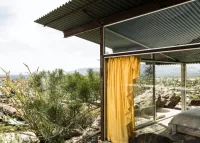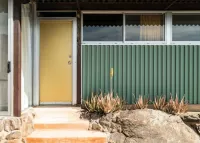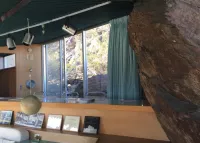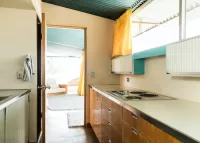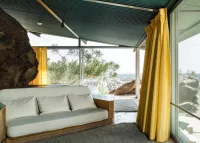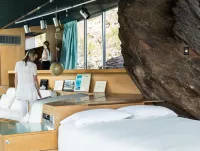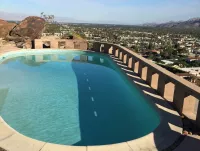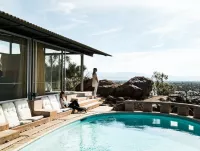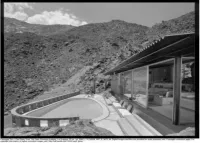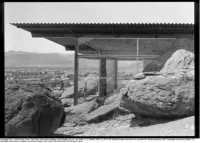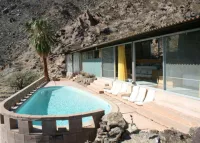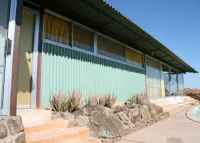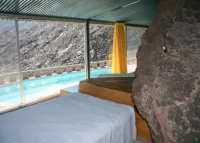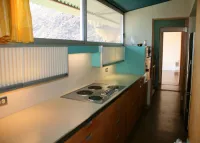Share what you know,
and discover more.
Share what you know,
and discover more.
Nov 01, 2016
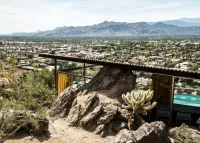
-

- Dave D
Albert Frey House II
Albert Frey House II By Kathryn Romeyn , AFAR Contributor Architecture geek or not, you only need a set of eyes to appreciate the Albert Frey House II. The innovative architect built his personal home on a mountain lot that to most people seemed uninhabitable, shaping a compact modernist glass-and-steel structure around a massive rock so it almost blends into the landscape. Even the interior takes its cues from the desert, with its original sky-blue ceiling and curtains to match the yellow Encelia flowers that bloom each spring. The glass invites in streams of light by day and reflects the stars at night, bringing the rooms to life in ways Frey surely planned. A longtime Palm Springs resident, Frey bequeathed his home to the Palm Springs Art Museum on his death in 1998, allowing it and its contents (including architectural drawings, correspondence, and personal effects) to be seen by people in the field of architecture. But even those not in the industry can get the full experience by booking through the Modern Tour at least 48 hours in advance. Tours are led by author and historian Michael Stern, who knew Frey—and many of the midcentury masters—so a deep dive full of insightful anecdotes is guaranteed.
Albert Frey House II
Albert Frey House II By Kathryn Romeyn , AFAR Contributor Architecture geek or not, you only need a set of eyes to appreciate the Albert Frey House II. The innovative architect built his personal home on a mountain lot that to most people seemed uninhabitable, shaping a compact modernist glass-and-steel structure around a massive rock so it almost blends into the landscape. Even the interior takes its cues from the desert, with its original sky-blue ceiling and curtains to match the yellow Encelia flowers that bloom each spring. The glass invites in streams of light by day and reflects the stars at night, bringing the rooms to life in ways Frey surely planned. A longtime Palm Springs resident, Frey bequeathed his home to the Palm Springs Art Museum on his death in 1998, allowing it and its contents (including architectural drawings, correspondence, and personal effects) to be seen by people in the field of architecture. But even those not in the industry can get the full experience by booking through the Modern Tour at least 48 hours in advance. Tours are led by author and historian Michael Stern, who knew Frey—and many of the midcentury masters—so a deep dive full of insightful anecdotes is guaranteed.
Nov 01, 2016
Albert Frey House II
Albert Frey House II By Kathryn Romeyn , AFAR ContributorArchitecture geek or not, you only need a set of eyes to appreciate the Albert Frey House II. The innovative architect built his personal home on a mountain lot that to most people seemed uninhabitable, shaping a compact modernist glass-and-steel structure around a massive rock so it almost blends into the landscape. Even the interior takes its cues from the desert, with its original sky-blue ceiling and curtains to match the yellow Encelia flowers that bloom each spring. The glass invites in streams of light by day and reflects the stars at night, bringing the rooms to life in ways Frey surely planned. A longtime Palm Springs resident, Frey bequeathed his home to the Palm Springs Art Museum on his death in 1998, allowing it and its contents (including architectural drawings, correspondence, and personal effects) to be seen by people in the field of architecture. But even those not in the industry can get the full experience by booking through the Modern Tour at least 48 hours in advance. Tours are led by author and historian Michael Stern, who knew Frey—and many of the midcentury masters—so a deep dive full of insightful anecdotes is guaranteed.
Posted Date
Dec 20, 2021
Historical Record Date
Nov 01, 2016
Source Name
Afar
Delete Story
Are you sure you want to delete this story?
Sep 28, 2015
Sep 28, 2015
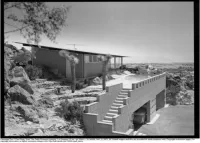
-

- Dave D
National Register of Historic Places - Summary
Summary Frey House II is situated on a steep and rocky slope 220 feet above Palm Springs. Albert Frey designed this small, one-story dwelling for himself in 1963. A rectangle of steel frame construction with plate glass windows, the house is capped by a corrugated metal shed roof. The interior steps up from the bedroom to a dining/living area, small kitchen, bathroom, and guest room. A large boulder enters the house from the north, becoming a divider between the bedroom and dining/living area. The house sits adjacent to a retaining wall of terracotta-colored concrete block forming a platform containing a swimming pool and a space below for a carport. A small guest room designed by Frey was added to the west end of the residence in 1970. Upon Frey’s death, the house was bequeathed to the Palm Springs Art Museum and is carefully maintained, exhibiting a high level of integrity. Narrative Description For Albert Frey, Mount San Jacinto was an imposing presence that, in his architecture, demanded to be addressed. It was the western view to which buildings in the alluvial basin of Palm Springs were designed to face. By the late 1950s, after 25 years of looking up at the mountain, Frey decided he would live there and look down. It took five years to find the right parcel, which was purchased from a man who thought it too steep to build on. Known as Frey House II (Frey House I on the valley floor has since been demolished), it soars 220 feet above Palm Springs. Begun in 1963 and completed in 1964, the house exemplifies Frey’s design philosophy that a building should meld into its desert environment. Located on a steep slope with natural rock outcroppings, Frey House II consists of two distinct elements (Figure 2). A retaining wall of poured concrete and terracotta-colored concrete block presses against the hillside, forming a platform containing a swimming pool and a space below for a carport. Typical of his post-World War II designs, the double-stacked concrete blocks are aligned and, at the carport, corners are cut at a diagonal at every other paired row. Steps lead from the driveway to the deck, which is enclosed by a concrete block railing interspersed with square openings. In contrast, the house itself is light and airy, a pure rectangle of steel-frame construction and plate glass, with corrugated metal used for the roof, overhang, ceiling and walls (Figure 3). The house is set precisely on an east-west axis. The thin shed roof angles downward toward the south, capping the composition, its slant precisely calibrated to take advantage of the angle of the sun (Figure 4). Said Frey of the deep overhangs, “The plan was designed so that, for instance, the glass walls are not exposed to the sun in the heat of summer. That’s what determined these overhangs. In winter, when the sun is much lower, it comes in and helps heat the house. I never need any heat after the sun comes up because the sun warms it.” As for his use of metal, “The weather is too hot for wood. Metal doesn’t retain heat—it cools off in minutes.” Inside the house, the concrete floor—dyed to match the local soil—steps down from the kitchen to the carpeted dining/living area following the slope of the terrain. Separating the sleeping area from the dining/living area is an enormous boulder that penetrates the house anchoring it to the environment (Figure 5). North facing glazing traces the rock’s contours. Frey noted, “Its gray granite probably took thousands of years to make this color. I have very strong opinions about the connection between architecture and nature.” Consistent with Frey’s belief in economy of space, the house contains seating, a dining area, and storage that are all built in. Careful attention was paid to color. Said Frey, “I used a blue ceiling because it blends with the sky. It makes it very restful. And then, as you see, the yellow curtains are like the blossoming encilia flowers.”4 The blue, perforated corrugated metal ceiling utilized by Frey appeared in other buildings such as the interior lobby of the Palm Springs Aerial Tramway Valley Station. In response to an interview question in 1986 about how his use of color was lost in the black and white photography that represented the house in publications of the time, Frey replied “Yes, color is so important because it ties in with the surrounding nature. For instance, these technical materials, like metal, become more dramatic when you look at the rock behind me, which is natural. It makes a rather exciting contrast.” To provide accommodations for guests, building permits confirm that Frey designed a small guest room at the west end of the house in 1970 costing approximately $4,000. Like the original house, it was of masonry and steel construction with a steel roof, and is fully compatible with the earlier composition. The ethereal nature of Frey House II differs greatly from the Arthur Elrod Residence designed four years later by John Lautner at a similar elevation across the basin in Palm Springs’ Southridge neighborhood. That house was built almost entirely of concrete, including the roof. Of it Frey later commented when queried, “The more weight you have, the more movement [in earthquakes]. Lautner’s is a very nice exciting house. He did a wonderful job with concrete. I prefer to use lighter materials.” Frey built his second house on a restricted budget. “I’m much more interested to get the most for the least money,” he said. “It’s a challenge that way. It’s easy to splash and spend a lot of money, but that’s not very interesting. Economy, after all, controls many things.” This philosophy expressed itself in the buildings Frey designed in the Coachella Valley from the 1940s through the 1960s. Frey avoided using expensive materials such as marble because he believed that they were inappropriate for the desert environment. “Materials should be used in a simple way,” he said, “and not try to pretend to be more than what [they are].” As relates to integrity, the original design, materials, and workmanship of the dwelling are unchanged except for the presence of a modest addition at the west end of the house that Frey designed in 1970. Location and setting are as they were since construction, and, given its long association with Albert Frey as his own residence, it is imbued with the feeling of the architect’s presence.
National Register of Historic Places - Summary
Summary Frey House II is situated on a steep and rocky slope 220 feet above Palm Springs. Albert Frey designed this small, one-story dwelling for himself in 1963. A rectangle of steel frame construction with plate glass windows, the house is capped by a corrugated metal shed roof. The interior steps up from the bedroom to a dining/living area, small kitchen, bathroom, and guest room. A large boulder enters the house from the north, becoming a divider between the bedroom and dining/living area. The house sits adjacent to a retaining wall of terracotta-colored concrete block forming a platform containing a swimming pool and a space below for a carport. A small guest room designed by Frey was added to the west end of the residence in 1970. Upon Frey’s death, the house was bequeathed to the Palm Springs Art Museum and is carefully maintained, exhibiting a high level of integrity. Narrative Description For Albert Frey, Mount San Jacinto was an imposing presence that, in his architecture, demanded to be addressed. It was the western view to which buildings in the alluvial basin of Palm Springs were designed to face. By the late 1950s, after 25 years of looking up at the mountain, Frey decided he would live there and look down. It took five years to find the right parcel, which was purchased from a man who thought it too steep to build on. Known as Frey House II (Frey House I on the valley floor has since been demolished), it soars 220 feet above Palm Springs. Begun in 1963 and completed in 1964, the house exemplifies Frey’s design philosophy that a building should meld into its desert environment. Located on a steep slope with natural rock outcroppings, Frey House II consists of two distinct elements (Figure 2). A retaining wall of poured concrete and terracotta-colored concrete block presses against the hillside, forming a platform containing a swimming pool and a space below for a carport. Typical of his post-World War II designs, the double-stacked concrete blocks are aligned and, at the carport, corners are cut at a diagonal at every other paired row. Steps lead from the driveway to the deck, which is enclosed by a concrete block railing interspersed with square openings. In contrast, the house itself is light and airy, a pure rectangle of steel-frame construction and plate glass, with corrugated metal used for the roof, overhang, ceiling and walls (Figure 3). The house is set precisely on an east-west axis. The thin shed roof angles downward toward the south, capping the composition, its slant precisely calibrated to take advantage of the angle of the sun (Figure 4). Said Frey of the deep overhangs, “The plan was designed so that, for instance, the glass walls are not exposed to the sun in the heat of summer. That’s what determined these overhangs. In winter, when the sun is much lower, it comes in and helps heat the house. I never need any heat after the sun comes up because the sun warms it.” As for his use of metal, “The weather is too hot for wood. Metal doesn’t retain heat—it cools off in minutes.” Inside the house, the concrete floor—dyed to match the local soil—steps down from the kitchen to the carpeted dining/living area following the slope of the terrain. Separating the sleeping area from the dining/living area is an enormous boulder that penetrates the house anchoring it to the environment (Figure 5). North facing glazing traces the rock’s contours. Frey noted, “Its gray granite probably took thousands of years to make this color. I have very strong opinions about the connection between architecture and nature.” Consistent with Frey’s belief in economy of space, the house contains seating, a dining area, and storage that are all built in. Careful attention was paid to color. Said Frey, “I used a blue ceiling because it blends with the sky. It makes it very restful. And then, as you see, the yellow curtains are like the blossoming encilia flowers.”4 The blue, perforated corrugated metal ceiling utilized by Frey appeared in other buildings such as the interior lobby of the Palm Springs Aerial Tramway Valley Station. In response to an interview question in 1986 about how his use of color was lost in the black and white photography that represented the house in publications of the time, Frey replied “Yes, color is so important because it ties in with the surrounding nature. For instance, these technical materials, like metal, become more dramatic when you look at the rock behind me, which is natural. It makes a rather exciting contrast.” To provide accommodations for guests, building permits confirm that Frey designed a small guest room at the west end of the house in 1970 costing approximately $4,000. Like the original house, it was of masonry and steel construction with a steel roof, and is fully compatible with the earlier composition. The ethereal nature of Frey House II differs greatly from the Arthur Elrod Residence designed four years later by John Lautner at a similar elevation across the basin in Palm Springs’ Southridge neighborhood. That house was built almost entirely of concrete, including the roof. Of it Frey later commented when queried, “The more weight you have, the more movement [in earthquakes]. Lautner’s is a very nice exciting house. He did a wonderful job with concrete. I prefer to use lighter materials.” Frey built his second house on a restricted budget. “I’m much more interested to get the most for the least money,” he said. “It’s a challenge that way. It’s easy to splash and spend a lot of money, but that’s not very interesting. Economy, after all, controls many things.” This philosophy expressed itself in the buildings Frey designed in the Coachella Valley from the 1940s through the 1960s. Frey avoided using expensive materials such as marble because he believed that they were inappropriate for the desert environment. “Materials should be used in a simple way,” he said, “and not try to pretend to be more than what [they are].” As relates to integrity, the original design, materials, and workmanship of the dwelling are unchanged except for the presence of a modest addition at the west end of the house that Frey designed in 1970. Location and setting are as they were since construction, and, given its long association with Albert Frey as his own residence, it is imbued with the feeling of the architect’s presence.
National Register of Historic Places - Summary
SummaryFrey House II is situated on a steep and rocky slope 220 feet above Palm Springs. Albert Frey designed this small, one-story dwelling for himself in 1963. A rectangle of steel frame construction with plate glass windows, the house is capped by a corrugated metal shed roof. The interior steps up from the bedroom to a dining/living area, small kitchen, bathroom, and guest room. A large boulder enters the house from the north, becoming a divider between the bedroom and dining/living area. The house sits adjacent to a retaining wall of terracotta-colored concrete block forming a platform containing a swimming pool and a space below for a carport. A small guest room designed by Frey was added to the west end of the residence in 1970. Upon Frey’s death, the house was bequeathed to the Palm Springs Art Museum and is carefully maintained, exhibiting a high level of integrity.
Narrative Description
For Albert Frey, Mount San Jacinto was an imposing presence that, in his architecture, demanded to be addressed. It was the western view to which buildings in the alluvial basin of Palm Springs were designed to face. By the late 1950s, after 25 years of looking up at the mountain, Frey decided he would live there and look down. It took five years to find the right parcel, which was purchased from a man who thought it too steep to build on. Known as Frey
House II (Frey House I on the valley floor has since been demolished), it soars 220 feet above Palm Springs. Begun in 1963 and completed in 1964, the house exemplifies Frey’s design philosophy that a building should meld into its desert environment.
Located on a steep slope with natural rock outcroppings, Frey House II consists of two distinct elements (Figure 2). A retaining wall of poured concrete and terracotta-colored concrete block presses against the hillside, forming a platform containing a swimming pool and a space below for a carport. Typical of his post-World War II designs, the double-stacked concrete blocks are aligned and, at the carport, corners are cut at a diagonal at every other paired row. Steps lead from the driveway to the deck, which is enclosed by a concrete block railing interspersed with square openings.
In contrast, the house itself is light and airy, a pure rectangle of steel-frame construction and plate glass, with corrugated metal used for the roof, overhang, ceiling and walls (Figure 3). The house is set precisely on an east-west axis. The thin shed roof angles downward toward the south, capping the composition, its slant precisely calibrated to take advantage of the angle of the sun (Figure 4). Said Frey of the deep overhangs, “The plan was designed so that, for instance, the glass walls are not exposed to the sun in the heat of summer. That’s what determined these overhangs. In winter, when the sun is much lower, it comes in and helps heat the house. I never need any heat after the sun comes up because the sun warms it.” As for his use of metal, “The weather is too hot for wood. Metal doesn’t retain heat—it cools off in minutes.”
Inside the house, the concrete floor—dyed to match the local soil—steps down from the kitchen
to the carpeted dining/living area following the slope of the terrain. Separating the sleeping area
from the dining/living area is an enormous boulder that penetrates the house anchoring it to the
environment (Figure 5). North facing glazing traces the rock’s contours. Frey noted, “Its gray granite probably took thousands of years to make this color. I have very strong opinions about the connection between architecture and nature.”
Consistent with Frey’s belief in economy of space, the house contains seating, a dining area, and storage that are all built in. Careful attention was paid to color. Said Frey, “I used a blue ceiling because it blends with the sky. It makes it very restful. And then, as you see, the yellow curtains are like the blossoming encilia flowers.”4 The blue, perforated corrugated metal ceiling utilized by Frey appeared in other buildings such as the interior lobby of the Palm Springs Aerial Tramway Valley Station.
In response to an interview question in 1986 about how his use of color was lost in the black and white photography that represented the house in publications of the time, Frey replied “Yes, color is so important because it ties in with the surrounding nature. For instance, these technical materials, like metal, become more dramatic when you look at the rock behind me, which is natural. It makes a rather exciting contrast.”
To provide accommodations for guests, building permits confirm that Frey designed a small guest room at the west end of the house in 1970 costing approximately $4,000. Like the original house, it was of masonry and steel construction with a steel roof, and is fully compatible with the earlier composition.
The ethereal nature of Frey House II differs greatly from the Arthur Elrod Residence designed four years later by John Lautner at a similar elevation across the basin in Palm Springs’ Southridge neighborhood. That house was built almost entirely of concrete, including the roof. Of it Frey later commented when queried, “The more weight you have, the more movement [in earthquakes]. Lautner’s is a very nice exciting house. He did a wonderful job with concrete. I prefer to use lighter materials.”
Frey built his second house on a restricted budget. “I’m much more interested to get the most for the least money,” he said. “It’s a challenge that way. It’s easy to splash and spend a lot of money, but that’s not very interesting. Economy, after all, controls many things.” This philosophy expressed itself in the buildings Frey designed in the Coachella Valley from the 1940s through the 1960s. Frey avoided using expensive materials such as marble because he believed that they were inappropriate for the desert environment. “Materials should be used in a simple way,” he said, “and not try to pretend to be more than what [they are].”
As relates to integrity, the original design, materials, and workmanship of the dwelling are unchanged except for the presence of a modest addition at the west end of the house that Frey designed in 1970. Location and setting are as they were since construction, and, given its long association with Albert Frey as his own residence, it is imbued with the feeling of the architect’s presence.
Posted Date
Dec 20, 2021
Historical Record Date
Sep 28, 2015
Source Name
United States Department of the Interior - National Park Service
Delete Story
Are you sure you want to delete this story?


